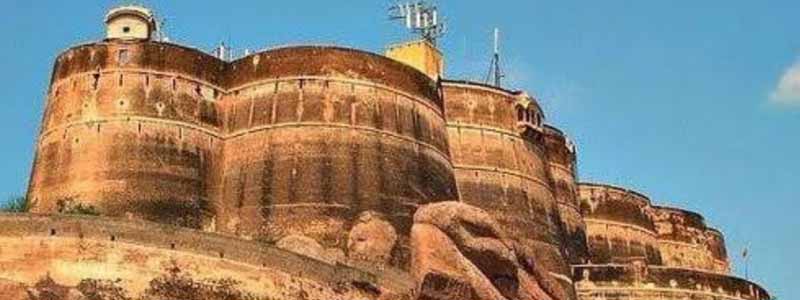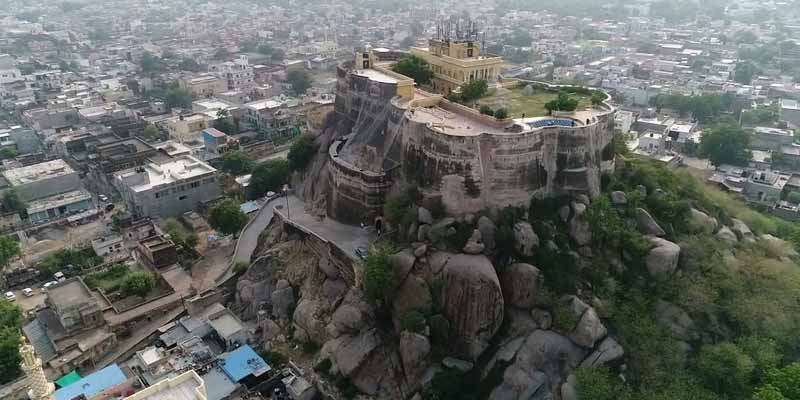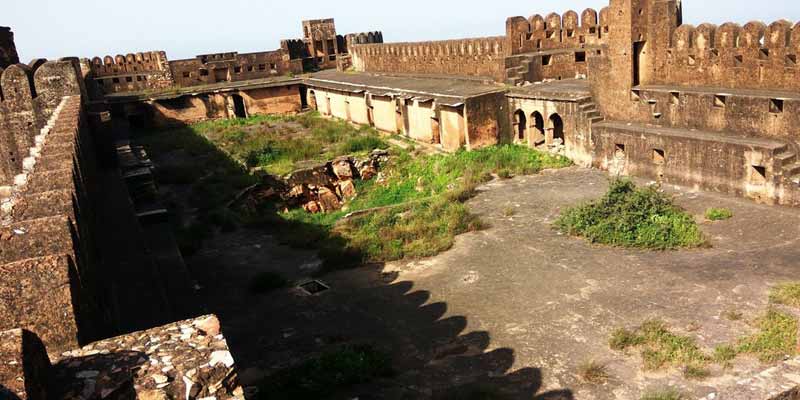Laxmangarh Fort, situated in Sikar, Rajasthan, stands as a testament to the region’s rich historical and architectural heritage. Constructed in the early 19th century by Laxman Singh, the fort overlooks the town of Laxmangarh and boasts a captivating fusion of Rajput and Mughal architectural styles.
This imposing structure is renowned for its sturdy walls, intricate frescoes, and elaborate artwork adorning its interiors. The fort’s strategic location atop a hill provides panoramic views of the surrounding landscape, offering visitors a glimpse into the region’s historical significance and natural beauty.
Exploring Laxmangarh Fort allows one to delve into Rajasthan’s glorious past, witnessing its grandeur through the intricately designed gates, courtyards, and palatial rooms within. The fort stands not just as a monument but as a living testament to the valor, culture, and craftsmanship of bygone eras, captivating the imagination of all who visit.

History of Laxmangarh Fort
Laxmangarh Fort is a historic structure located in the town of Laxmangarh in Sikar district, Rajasthan, India. Built during the early 19th century, the fort stands as a testament to the architectural prowess and strategic planning of that era.
Construction of Laxmangarh Fort began in 1805 under the supervision of Laxman Singh, the ruler of Sikar. The fort was named after him and was designed to serve as a stronghold against invasions and to ensure the safety of the town’s inhabitants. Its location atop a hill provided a natural advantage for defense and surveillance, allowing for a clear view of the surrounding areas.
The architecture of the fort reflects a fusion of Rajputana and Mughal styles. Its massive walls, bastions, and ramparts were constructed using red sandstone, giving it a formidable appearance. The fortification includes numerous gates, namely, Suraj Pol, Chand Pol, and Sikar Pol, each intricately designed with detailed carvings and decorations.
Within the fort complex, there are several structures such as temples, havelis (mansions), courtyards, and reservoirs. These structures exhibit elaborate frescoes, exquisite artwork, and intricate designs that showcase the rich cultural heritage of Rajasthan.
Laxmangarh Fort played a significant role in various historical events and battles in the region. Over time, the fort has witnessed the shifting tides of power and control, experiencing periods of prosperity and turmoil.
Today, Laxmangarh Fort stands as a prominent tourist attraction, drawing visitors with its historical significance, architectural brilliance, and panoramic views of the town and its surroundings. Restoration efforts by the government and local authorities aim to preserve this heritage site for future generations, allowing visitors to explore and appreciate the grandeur and history encapsulated within its walls.

Places to Visit around Laxmangarh Fort
Laxmangarh Fort, located in Sikar, Rajasthan, India, is a historical marvel with a rich cultural heritage. If you’re visiting the area, there are several nearby places worth exploring:
Fatehpur: Just around 13 kilometers from Laxmangarh, Fatehpur is known for its havelis (traditional mansions) adorned with beautiful frescoes. The Sethani ka Johara, a large stepped water reservoir, is also a prominent attraction here.
Nawalgarh: About 30 kilometers from Laxmangarh, Nawalgarh is another town famous for its stunning frescoed havelis. Places like Morarka Haveli Museum, Anandi Lal Poddar Haveli, and Roop Niwas Palace are worth visiting to witness the artistry of the region.
Mandawa: Roughly 45 kilometers away, Mandawa is renowned for its elaborate frescoes and beautifully decorated havelis. Some must-visit havelis include Hanuman Prasad Goenka Haveli, Murmuria Haveli, and Jhunjhunwala Haveli.
Shekhawati Region: Laxmangarh is situated in the heart of the Shekhawati region, which is dotted with numerous small towns and villages, each boasting intricately painted havelis and forts. Exploring this region will provide you with a rich cultural experience.
Khatu Shyamji Temple: Located around 70 kilometers away, this temple dedicated to Khatu Shyamji (a revered deity) attracts a large number of devotees, especially during festivals.
Sikar: While you’re in the vicinity, exploring Sikar itself can be rewarding. Visit the Madho Niwas Kothi, Devgarh Fort, and various temples in the city.
Jeetpura: Known for its architectural marvels, Jeetpura, around 18 kilometers from Laxmangarh, houses beautiful frescoes and havelis that showcase the artistic brilliance of the region.
Remember, the Shekhawati region is known for its exquisite frescoes, intricate artwork, and historical significance. Exploring these nearby towns and villages will offer a glimpse into Rajasthan’s rich cultural heritage.

Best time to visit Laxmangarh Fort
The best time to visit Laxmangarh Fort in Sikar, Rajasthan, largely depends on weather preferences and personal interests. However, the ideal period to explore the fort and its surroundings is during the winter season, spanning from October to March.
During these months, the weather in Sikar is relatively pleasant and favorable for sightseeing and outdoor activities. The temperatures are milder, ranging from around 10°C to 25°C, making it comfortable for visitors to explore the fort without being affected by extreme heat.
Additionally, the winter months coincide with several cultural festivals and events in Rajasthan, offering a chance to experience the vibrant local culture, traditions, and festivities in Sikar. The clear skies and cooler climate during this time also provide excellent opportunities for photography and enjoying panoramic views from the fort.
Visiting during the winter season ensures an enjoyable and comfortable experience, allowing travelers to fully appreciate the historical and architectural marvels of Laxmangarh Fort in Sikar.
How to Reach Laxmangarh Fort
Laxmangarh Fort in Sikar, Rajasthan, is an iconic historical site with architectural marvels and cultural significance. To reach Laxmangarh Fort, you can follow these steps:
By Air: The nearest airport to Laxmangarh Fort is Jaipur International Airport, located approximately 150 kilometers away. From Jaipur, you can hire a taxi or take a bus to Sikar and then proceed to Laxmangarh Fort.
By Train: Sikar Junction is the closest railway station to Laxmangarh Fort. Several trains connect Sikar with major cities like Delhi, Jaipur, and other parts of Rajasthan. From the Sikar railway station, you can hire a taxi, auto-rickshaw, or take a local bus to reach the fort.
By Road: Sikar is well-connected by roads to various cities in Rajasthan. You can take a bus or drive via NH52 or other state highways to reach Sikar. Once in Sikar, Laxmangarh Fort is easily accessible by local transport options like taxis, auto-rickshaws, or even by walking, as it’s a prominent landmark.
Upon reaching Sikar, the fort is situated in the town of Laxmangarh itself. It’s advisable to inquire about local transportation options or directions from the townspeople to reach the fort as it might not be directly visible from a distance due to its location within the town.
Laxmangarh Fort’s historic charm and architectural splendor make it a must-visit destination for history enthusiasts and tourists exploring the rich heritage of Rajasthan.








